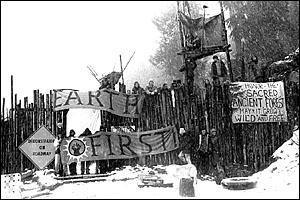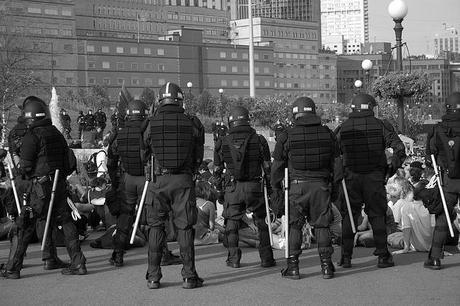by Panagioti Tsolkas, Earth First! Newswire
[a shorter version of this article was originally published by Earth Island Journal]
A brief introduction from an Earth First! organizer
In 1998, I found myself traveling among Earth First! activists and living in an Oregon road blockade. Beyond the blockade were a series of treesits designed to protect an ancient forest from industrial logging. It was the first movement that I really felt a part of, though I have to admit that I was skeptical about any potential for victory. But the feeling was right, so I stuck with it. Today, you can go to where that grove of giant Douglas fir trees near Fall Creek is still standing and see the results of our actions for yourself.

“There has been a visible rise in direct action campaigns against energy corporations and their infrastructure.” Photo by Elizabeth Brossa
The same is true for a dozen-or-so other timber sales that were contested in the area. And in places where native forests were lost to the saws, we made sure they were not forgotten – images of us standing on massive stumps became burned into brains around the world. Rather than stifling us with sadness, these losses became fuel for our fight. It was only in hindsight that I realized our publicity generated through daring protests also played a role in changing the actual language people were using to talk about ecosystem protection, and as a result, the public policy surrounding forestry.
More than that, our experience in the backwoods gave us the skills, analysis, and affinity groups we needed to descend on Seattle a few years later and derail the global economy’s WTO meeting with blockades throughout the city center.
A very similar scenario is playing out across the US right now, visible in the rise of direct action campaigns against energy corporations and their infrastructure. The clearest example I can point to at the time of writing this is a tree canopy occupation on Andarko’s proposed fracking site in Pennsylvania’s Loyalsock State Forest. But that campaign, which has been playing out in various installments since summer, is one of many where radical activists have recently taken to the woods and stood in the way of pipeline construction, fracking wells, tar sands and coal mining sites.

- About Earth First!, NGOs And Direct Action
Direct action is one of the three tenets that defined Earth First! in its earliest days, and it has continued to be a defining focus of the movement. While there was never intended to be a hierarchy of these tenets, the other two—biocentric worldview and no-compromise strategy—would only be lifeless textbook theories without direct action to back them up.
For over 30 years now, Earth First! (EF!) activists have dedicated themselves to honing the strategic applications of direct action and using it to expose, confront and reverse the destruction of the planet.
Many folks only know of the EF! movement from an occasional sensational news headline over the last few decades: the bombing of Judi Bari, the tree-spiking debate, the inspiration of Ted Kaczynski, the ELF arsons, wolf hunt sabotage, etc.While those stories all have an interesting place in the movement’s history, the core ideas and experiences of EF! are much more relevant to the current direction of the environmental movement than they get credit for. Perhaps the clearest example being the rise of civil disobedience by bigger and broader-reaching organizations, including the 120-year-old Sierra Club as well as relative new-comers such as 350.org and Credo (yes, the phone company).
It’s exciting, on one hand, to see new groups step up to the plate and take bolder approaches to environmental protection. It’s also disconcerting to see so much of the actual strategizing and coordination come from a top-down style of organizing, common among big NGOs. Direct action should come from grassroots participation. NGOs can be very helpful in offering various kinds of support, but the more they try to run the show, the weaker the integrity of our story.
The spirit of direct action, as Earth First! practices it, seeks to model the goals it aims to manifest. For example, when challenging state bureaucrats or corporate lobbyists, the principles of consensus decision making and respect for autonomy are high priorities for affinity groups wishing to pull off effective, empowering direct actions.
Image above is from the Cascadia Free State at Warner Creek, ’96
Many of these folks are organizing under various organizational banners today, but experiences of working with Earth First! (EF!) have continued to be uniquely valuable to the direction of the environmental movement. I would like to share some insight here on ecological direct action gained through the past 15 years of on-the-ground EF! organizing experience.
Defining It
While the term civil disobedience is something people tend to be familiar with, it has long been considered merely one of the myriad tools in the toolbox of what social movements have historically called direct action. But direct action is something that is easier to describe through the sensations and stories that accompany it than through technical explanations. In a most bare-bones definition, using direct action means recognizing what efforts we – as individuals or affinity groups – can take which will result in achieving our goals without awaiting permission from authorities. In a money-driven society, that most often means diminishing the profit motive of our industrial opponents and threatening the political structures that prop them up.
Despite years of experience and knowledge now spanning generations, it’s still a challenge to describe exactly what sort of actions fall in this category. Generally accepted on the list are endless varieties of blockades, occupations, and sabotage of all shapes and forms (what we refer to as monkeywrenching); though things like mass marches, home demos, banner hangs, costly administrative petitions, and pro-se legal challenges (or paperwrenching), political pranks and miscellaneous deviltry also often make the cut – depending on who you’re talking to.
There have been debates ad nauseam about which actions actually have a direct impact and which are merely symbolic. As assorted activists, organizers, and revolutionaries have quickly realized, this is a false dichotomy. Most every action taken has both direct and symbolic effects, and it’s entirely possible that the supposed “symbolic” effect will far outweigh the immediate physical impact.
Take, for example, an average Earth Liberation Front (ELF) arson or Earth First! road blockade aimed at stopping development plans in the protected habitat of an endangered species. Either of these actions would likely cause a temporary delay in work progress and could cost a company or government agency tens-of-thousands of dollars in immediate financial losses. Mass media coverage of these events could drive the cost much higher. For one, contracting public relations firms to clean up a company’s tarred image is really f–ing expensive. Add to that increased insurance premiums and security costs that accompany bad publicity and you are easily in the hundreds-of-thousands range, if not millions.
More often than not, the story itself becomes the battleground. Not just on a moral or feel-good level, but on the impacts to a company’s bottom-line, and a state agency’s creditability.
Using It

“High profile civil disobedience actions like these can result in quick arrests.” Photo by Brendan Scherer
Blocking access to the roads needed for mining, occupying the offices they make their plans in, burning the equipment needed for logging – these few tactics alone would ideally stop our opponents dead in their tracks. Occasionally they have. But the records show, sadly, they usually don’t. High profile civil disobedience actions like these can result in quick arrests, and sneaky sabotage can lead to long prison sentences.
While we have the police state to thank for that, simply complaining about the cops doesn’t tend to get us much closer to our goals either (though a good old-fashioned riot can go a long way in applying some pressure, as it did on a few occasions for suffragists, labor, civil rights…) This unfortunate reality of a system that is armed to the teeth against us means that our efforts need to be more dynamic, resilient and effective at using all the story-telling media we can access.
All this doesn’t change the fact that the best long-term strategy for the environmental movement, or any movement, is to plan direct actions with a vision of what could achieve the most successful results if the police were removed from the picture. It might sound a little far fetched, but it makes our story so much stronger to honestly say “If the police state would stop siding with these corporations, we could shut down this facility that’s poisoning us for good, today.”
And some times it works. Take the infamous Love Canal campaign, a foundational moment for the modern environmental movement, for example. Did you know it was founded on a successful direct action event? It’s true.
On May 17, 1980 the Environmental Protection Agency (EPA) announced the result of blood tests that showed pollution-related chromosome damage in residents of the neighborhood in Niagara Falls, New York, indicating that they were at increased risk of cancer, reproductive problems and genetic damage. Two days later, residents held two EPA representatives hostage and challenged the White House to relocate all families by May 21 at noon, with then-president of the Love Canal Homeowners Association, Lois Gibbs, saying “What we’ve done here today, will look like a Sesame Street picnic compared to what we’ll do then.” The White House promptly agreed to evacuate all Love Canal families. (Wouldn’t you love to see that quick of a response in your local campaign – preferably before your family is dying of cancer?)
In the time that I’ve been involved with grassroots organizing and direct action, I’ve not only been a part of having logging plans canceled out in the West. Where I live, I’ve watched as plans for thousands of homes to be built over farms and wetlands that our group fought got scrapped. I’ve seen plans for gas storage facilities and pipelines we opposed be abandoned. I’ve celebrated as permitting for coal and nuclear power plants were shot down. And I’ve laughed as blueprints for a biotech city (animal testing labs and all) sit on hold for close to a decade – despite near a billion dollars in subsidies – thanks to our actions.
I have EF! organizer friends across the US who can tell similar stories. We didn’t usually achieve these victories on our own. Most often, it was a combination of direct action, broad opposition, and environmental lawsuits. But sometimes it really was just our rag tag direct action crew. And on more than one occasion, our reputation preceded us enough that their plans were canceled before we ever had a chance to throw up a first blockade!
A Few Final Tips
- Don’t be bound by the status quo rhetoric about violence or terrorism, but don’t be dragged into pseudo-militant bravado either. Let your instincts and intuitions play a role in determining this.
- Know when to look towards developing new tactics, but don’t be afraid to dust off some tried and true methods from the movement’s history.
- There are plenty of other books, pamphlets and articles to be found for elaboration on the subject—you could probably find some week long trainings on the subject if you track down your local EF! crew. Once again, nothing takes the place of experiencing it yourself.
- Oh, and don’t ignore the power of a post-action debrief. The idea is that our actions should be getting better every time.
Ultimately, direct action isn’t about hoping for change, it’s about making a commitment to fight for your family, friends, and the planet you depend on for life.
—————–
Panagioti is an editor on the Earth First! Journal and an organizer with Everglades EF!. He has fought dozens of corporations and state agencies, participating in blockades, occupations, paper-wrenching lawsuits and mass mobilizations across the US and abroad. He’s been arrested 18 times as a result of direct actions between 1997 and 2013, and was named “Troublemaker of the Year” in New Times magazine, 2009. This introductory article is one of a collection of writings on the basics of direct action. The EF! Media Project, which he is also a part of, is in the process of coordinating to release an updated version of the Earth First! Direct Action Manual. It is due out early next year and will include details on carrying out many tactics mentioned in the above article.
Wanna see more EF! News and analysis. Support us by donating here!

